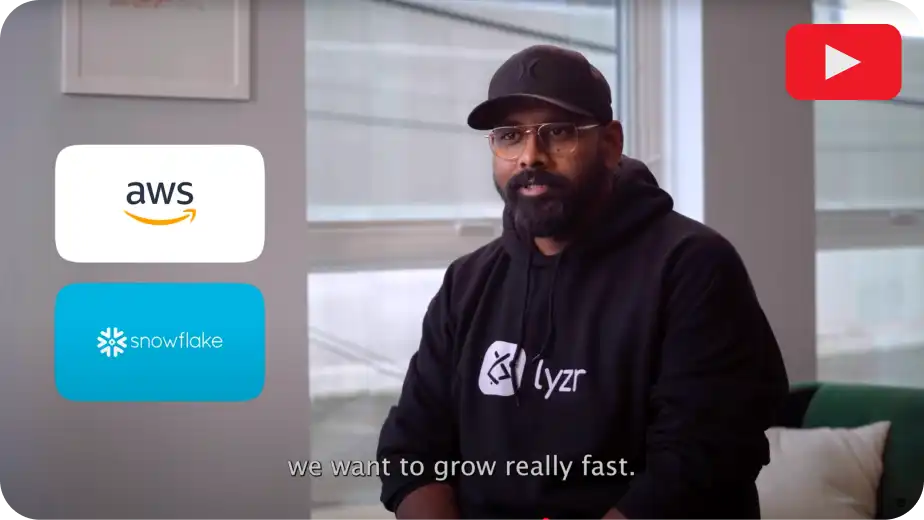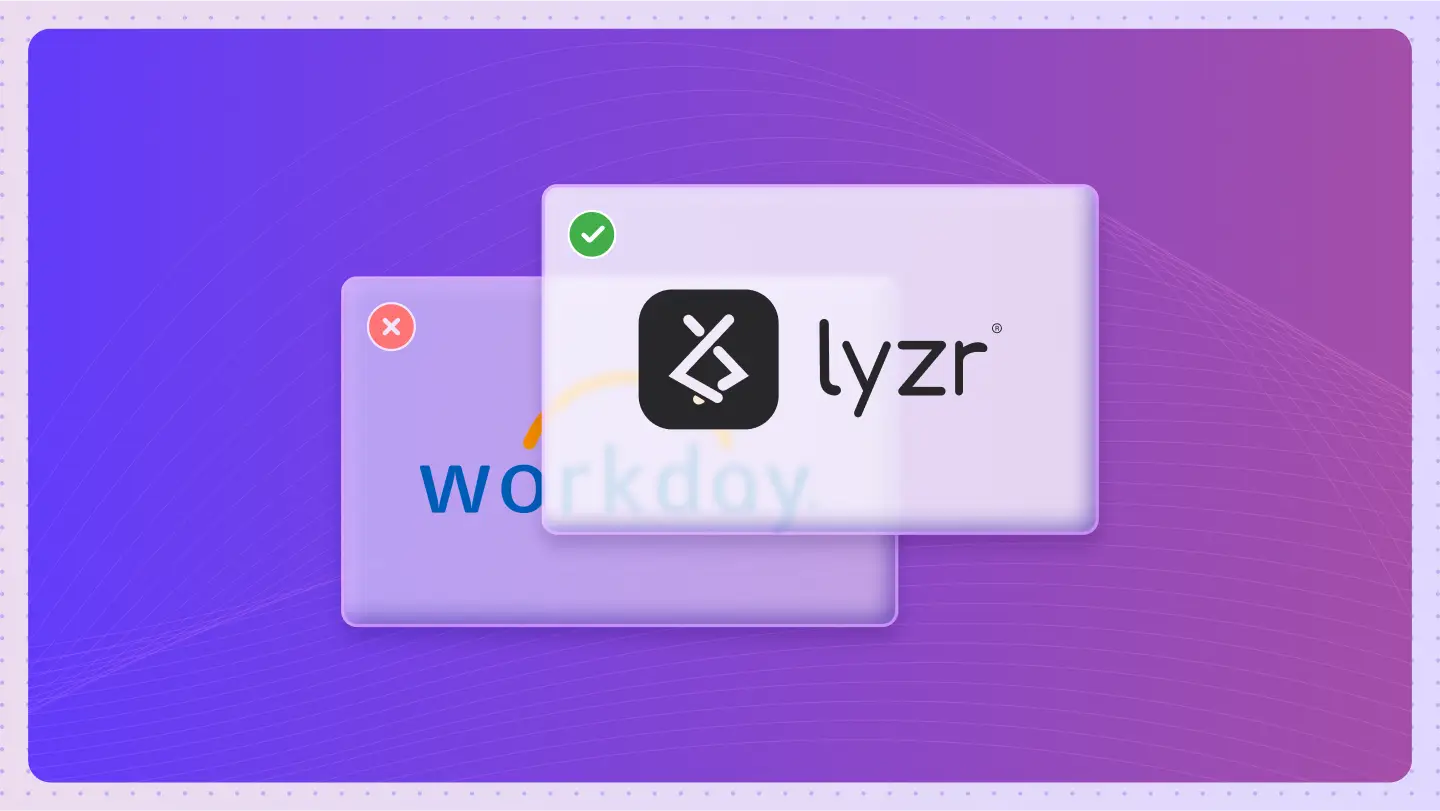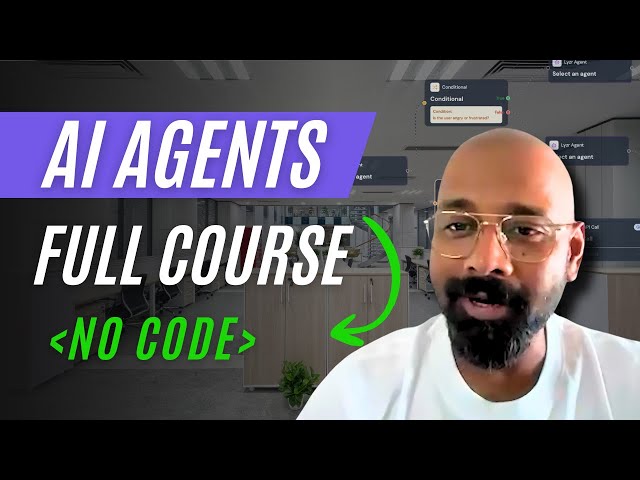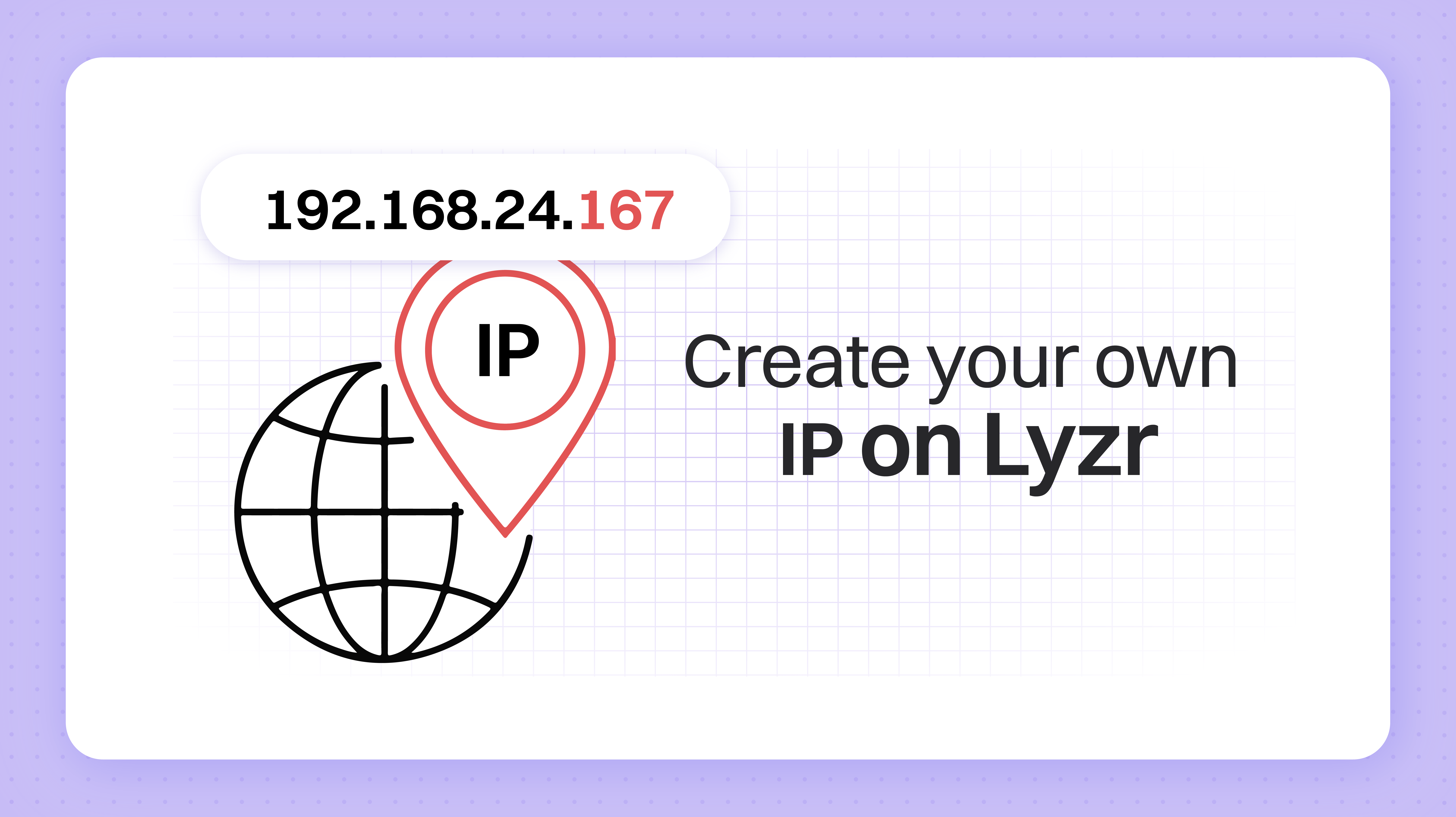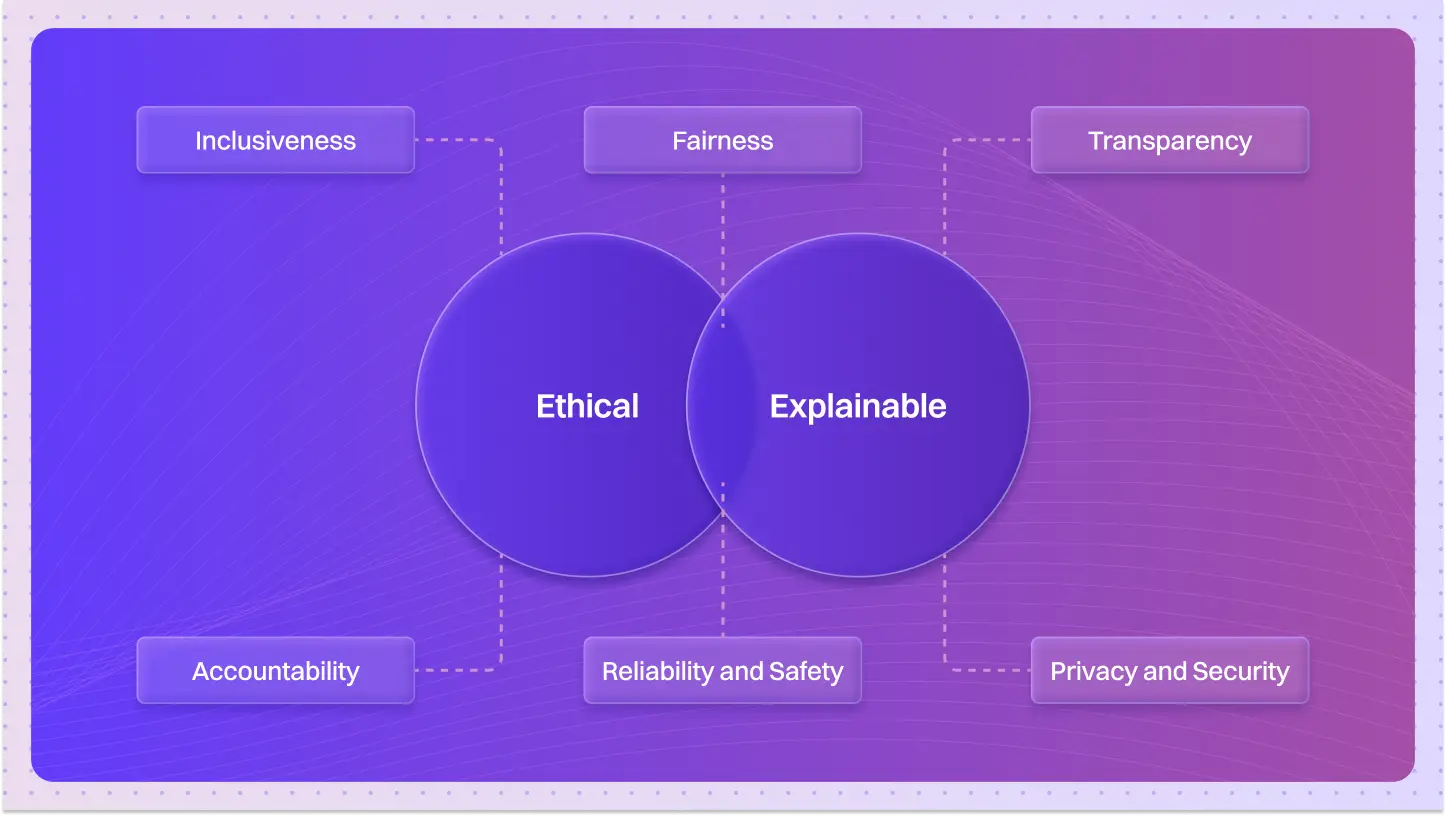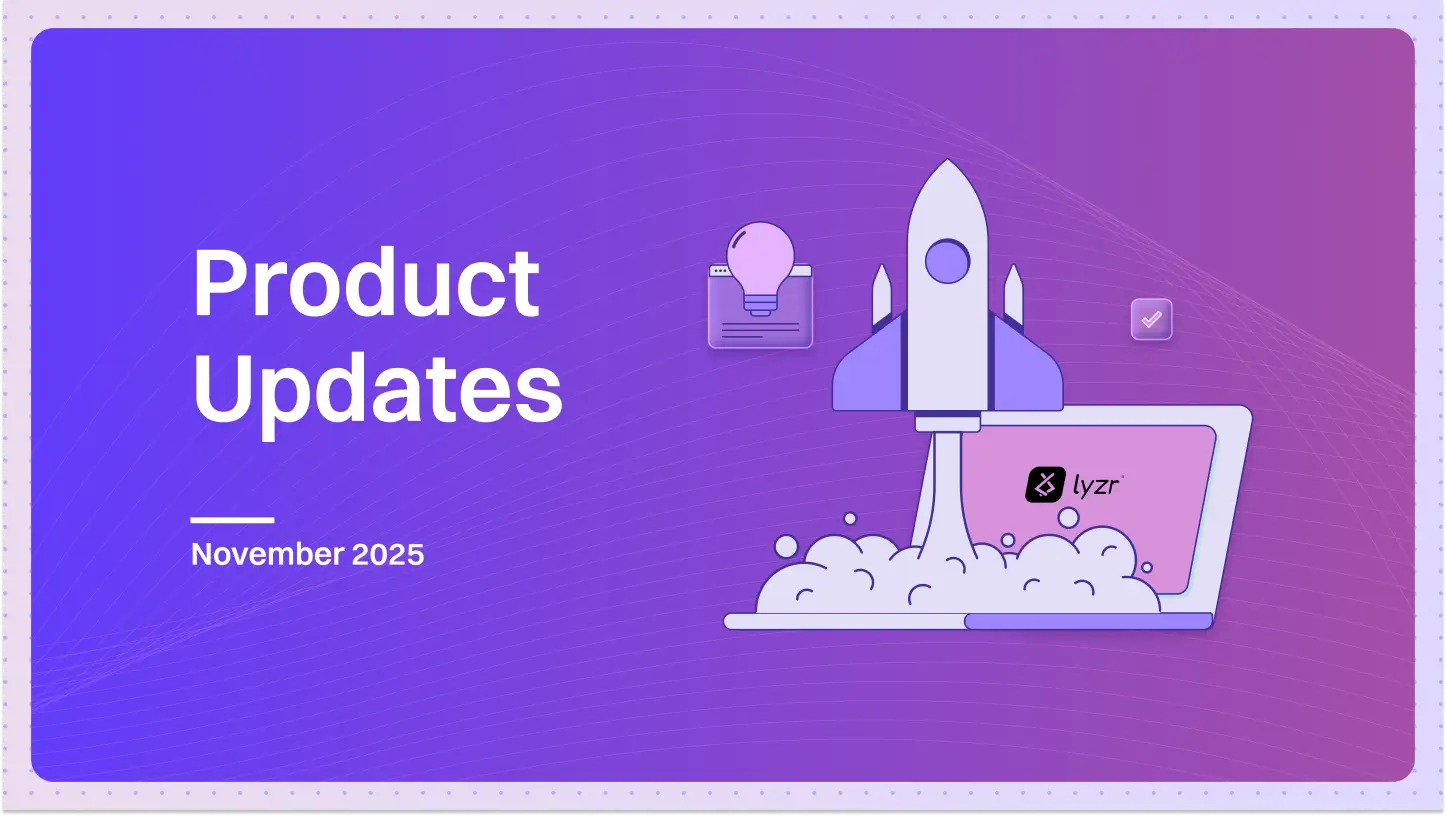Table of Contents
ToggleWe are seeing an increased pattern of customers building world-class AI applications on Lyzr. In this article, I will be covering how they approach building their IP with Lyzr.
What is Lyzr?
Lyzr is an enterprise agent framework for building reliable, self-learning AI agents. Think of a layer that sits between LLMs like GPT-4o or Claude 3.5 Sonnet and the front end application. Lyzr’s agents are reliable, i.e., they produce consistent output most times ensuring predictability of the AI workloads. Lyzr’s flexible and versatile agent framework allows customers to build all kinds of AI applications, from chatbots to complex workflow automation agents.
Let’s see the steps involved in a customer journey of building AI applications.
- Identify a painpoint or an opportunity to automate a process with AI
- Break down the steps involved in automating the process (Lyzr Professional Services can help customers here)
- Build an AI agent for each step of the process (this will be an iterative approach)
- Once the individual agents do what they are supposed to do, assemble them in a flow
- Test the newly formed MetaAgent (collection of agents), iterate with prompts to improve results
- Stress test the MetaAgent against possible test cases to detect failure points
- Do a soft launch, monitor, give feedback, improve agents before full production launch
This whole process could be completed within 24 hours. Lyzr’s newly launched Agent API is powerful and easy to use, allowing rapid experimentations.
So, what’s customer IP, what’s not?
Any business logic including the system prompts, related contextual data, agent generated data and the application layer forms the customer IP. The architecture below best describes what’s included in customer IP and what’s not.
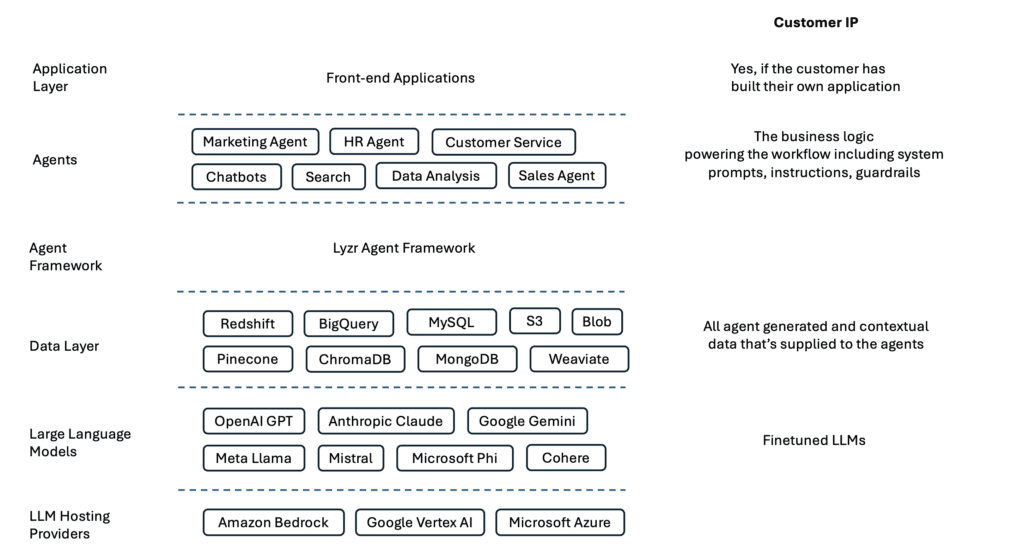
As you could see, any customizations that the customers build on Lyzr Agent Framework belongs to the customer. Let’s see them one by one.
Finetuned LLM – If you end up finetuning an LLM, then you could claim it as an IP. Finetuning an open-source model gives more control on the IP over finetuning a frontier model. With open-source models like Llama3 improving rapidly, and the evolution of robust model hosting providers like Groq, Hugging Face, etc, we see more IP built with fine-tuning.
Agent Generated Data – Agents generate output, but also generates artifacts, logs, etc. While Lyzr agent framework captures all, this is an IP that customers could claim.
Contextual Data – For most agents to perform in-context tasks, you will have to supply contextual data. This includes the ‘tribal knowledge’ that the customers hold in the form of structured or unstructured data.
Business Logic – Agents are only as good as the business logic that powers them. For the agents built on Lyzr, customers own the IP of the workflow.
System Prompts – System Prompts are like the frontal cortex part of the brain for AI agents. The better the prompts, the better the agents. Lyzr’s MagicPrompts and Anthropic’s Prompt Generator are some of the services that helps customers write better prompts. Prompts are an IP that customers can claim.
Instructions – Agents tend to perform better if the instructions are clear. Writing instructions to an LLM powered agent is an art in itself. One who understands how LLMs work tend to write better instructions. Instructions can also be claimed an IP.
Custom Code – Some agents may require additional code to be written to perform a more deterministic task. These code blocks are accessed by the agents through function calling.
Application Layer – Agents could run in the backend with developers tweaking the agents’ performance. But with a good interactive front-end, agents could be lot more fun and useful. Applications like Jasper, Perplexity won the hearts of several thousand users due to their intractive UI.
So, what’s not an IP that the customers can claim?
Agent Framework – The agent framework, like Lyzr or a Cohere, cannot be claimed as an IP.
Agent Features – The built-in agent features like ALHF (Agent Learning from Human Feedback), Self-Reflection, Toxicity Controller, etc cannot be claimed as customer’s IP.
LLMs – Be it the open-source LLMs or frontier models, they do not come under customer IP. The finetuned LLMs could be claimed as an IP though.
So as you may see, customers get a wider canvas of claimable IP which helps them win more customers, secure funding and grow faster. The benefit of building on a platform like Lyzr is that, customers can move out of Lyzr but still retain all their IP. Lyzr runs locally on customers cloud and hence no data leaves customer environment, ever. So this leaves just the framework which could be replaced with custom code built from scratch.
How are customers building their own IP on Lyzr?
We are witnessing an increasing trend of customers leveraging Lyzr to build world-class AI applications. In this comprehensive article, we’ll explore how these innovative companies approach building their intellectual property (IP) using the Lyzr platform.
What is Lyzr?
Lyzr is a cutting-edge enterprise agent framework designed for building reliable, self-learning AI agents. Conceptually, it functions as an intermediary layer positioned between large language models (LLMs) like GPT-4 or Claude 3.5 Sonnet and the front-end application layer.
Key features of Lyzr include:
- Reliability: Lyzr’s agents are engineered to produce consistent output in most scenarios, ensuring predictability of AI workloads. This reliability is crucial for enterprise applications where consistency is paramount.
- Flexibility: The framework’s versatile nature allows customers to build a wide array of AI applications, ranging from simple chatbots to complex workflow automation agents.
- Self-learning Capability: Lyzr agents can improve their performance over time, adapting to new information and feedback.
Customer Journey: Building AI Applications with Lyzr
Let’s delve into the step-by-step process that customers typically follow when building AI applications using Lyzr:
- Identify a Pain Point or Automation Opportunity:
- Recognize a business process or challenge that could benefit from AI automation.
- Assess the potential impact and feasibility of an AI solution.
- Break Down the Process:
- Analyze and deconstruct the steps involved in automating the identified process.
- Lyzr Professional Services can provide valuable assistance at this stage, offering expertise in process analysis and AI implementation strategies.
- Build Individual AI Agents:
- Develop an AI agent for each step of the process.
- This is typically an iterative approach, involving continuous refinement and optimization.
- Assemble Agents into a Workflow:
- Once individual agents are functioning as intended, combine them into a cohesive workflow.
- This step creates a “MetaAgent” – a collection of agents working in concert.
- Test and Refine the MetaAgent:
- Rigorously test the newly formed MetaAgent.
- Iterate on prompts and agent configurations to improve results and overall performance.
- Stress Testing:
- Subject the MetaAgent to a variety of test cases.
- Identify and address potential failure points to enhance robustness.
- Soft Launch and Monitoring:
- Deploy the MetaAgent in a controlled environment.
- Closely monitor its performance and gather user feedback.
- Use insights to further improve individual agents before full production launch.
One of the most remarkable aspects of this process is its speed. With Lyzr’s powerful and user-friendly Agent API, the entire development cycle can potentially be completed within 24 hours to 2 weeks. This rapid turnaround time allows for quick experimentation and iteration, accelerating the overall development process.
Understanding Customer IP in the Lyzr Ecosystem
A critical aspect of building AI applications on any platform is understanding what constitutes customer IP. With Lyzr, customers retain ownership of a significant portion of their work. Let’s break down what is and isn’t considered customer IP when building on Lyzr.
What Constitutes Customer IP?
- Business Logic:
- This includes system prompts, related contextual data, and the overall workflow design.
- The customer owns the architecture and decision-making processes embedded in the agents.
- Agent-Generated Data:
- Output produced by the agents, including artifacts and logs.
- While Lyzr’s framework captures this data, it’s considered the customer’s IP.
- Contextual Data:
- Any ‘tribal knowledge’ supplied to the agents in the form of structured or unstructured data.
- This proprietary information is crucial for in-context tasks and remains the customer’s IP.
- System Prompts:
- The carefully crafted instructions that guide the AI agents’ behavior.
- These are analogous to the “frontal cortex” of the AI agents and are a valuable IP asset.
- Instructions:
- The specific directives given to agents to perform tasks.
- Well-written instructions, which require an understanding of LLM behavior, are considered IP.
- Custom Code:
- Any additional code written to perform deterministic tasks.
- These custom code blocks, accessed by agents through function calling, are customer IP.
- Application Layer:
- The front-end interface and user experience design.
- A well-designed application layer can significantly enhance the utility and appeal of AI agents.
- Finetuned LLMs:
- If a customer finetunes an LLM for their specific use case, this customized model can be claimed as IP.
- Finetuning open-source models (like Llama3) often provides more control over IP compared to finetuning proprietary models.
What’s Not Considered Customer IP?
- Agent Framework:
- The underlying Lyzr framework itself cannot be claimed as customer IP.
- Built-in Agent Features:
- Pre-built functionalities like ALHF (Agent Learning from Human Feedback), Self-Reflection, and Toxicity Controller are part of Lyzr and not customer IP.
- Base LLMs:
- The foundational language models, whether open-source or proprietary, are not customer IP.
- However, as mentioned earlier, finetuned versions of these models can be claimed as IP.
The Advantages of Building on Lyzr
Building AI applications on Lyzr offers several key benefits:
- Extensive IP Ownership: Customers can claim a wide range of IP elements, which can be crucial for winning customers, securing funding, and driving growth.
- Portability: Customers have the flexibility to move their solutions off Lyzr while retaining all their IP. This reduces vendor lock-in concerns.
- Data Security: Lyzr runs locally on the customer’s cloud infrastructure, ensuring that no data ever leaves the customer’s environment. This addresses critical data privacy and security concerns.
- Rapid Development: With Lyzr’s powerful Agent API and pre-built features, development time is significantly reduced, allowing for quick experimentation and iteration.
- Scalability: The framework is designed to handle enterprise-scale applications, allowing customers to grow their AI solutions alongside their business needs.
- Access to Cutting-edge AI: Lyzr provides access to state-of-the-art AI capabilities without the need for deep expertise in AI development.
Conclusion
As the AI landscape continues to evolve, enterprise AI platforms like Lyzr are empowering businesses to harness the power of advanced AI technologies while maintaining control over their intellectual property. By providing a robust framework for AI agent development, Lyzr enables companies to focus on solving their unique business challenges, confident in the knowledge that their innovations and proprietary information are protected.
The combination of rapid development capabilities, extensive IP ownership, and the flexibility to evolve beyond the platform makes Lyzr an attractive option for businesses looking to build world-class AI applications.
Book A Demo: Click Here
Join our Slack: Click Here
Link to our GitHub: Click Here


